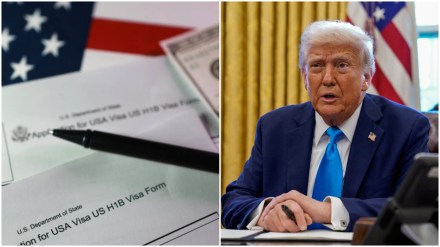Last month, US President Donald Trump announced a plan that would require the companies in US to pay $100,000 each year for H-1B visas. These visas allow businesses to temporarily hire skilled foreign workers in fields like technology and engineering. The move, which followed a lot of backlash and created ripple effect of fear and anxiety amongst people on H-1B visas, was described as part of Trump’s effort to essentially change how this program works.
Now, the US Chamber of Commerce filed a lawsuit against the Trump administration on Thursday, aiming to stop the steep hike in H-1B visa fee. This marks the Chamber’s first legal challenge against the administration in this term.
According to the lawsuit filed in the US District Court for the District of Columbia, the Chamber argues that Trump’s decision to impose the fee hike on H-1B visa applications, goes against the Immigration and Nationality Act.
The business group described the new fee as “not only misguided policy” but “plainly unlawful.” It has asked the court to block the fee and rule that the administration does not have the authority to impose it.
This lawsuit isn’t the first challenge to the new visa fee, but it’s important because it’s the first one filed by the Chamber which is one of the biggest and most influential business groups in Washington.
What does the lawsuit say?
Neil Bradley, the executive vice president of the US Chamber of Commerce, in a statement said the $100,000 visa fee would make it “cost-prohibitive for US employers”, especially startups and small or medium-sized firms, to utilise the H-1B program. He added that the program was originally created to help US businesses of all sizes hire skilled workers from around the world and expand their operations within the country.
‘Incremental step towards necessary reforms to H-1B program’: White House
White House spokeswoman Taylor Rogers defended the administration’s move, saying it was legal and an important first step toward reforming the H-1B visa program. Rogers said that Trump’s decision was meant to protect American workers by preventing companies from misusing the visa system or lowering US wages, while still allowing businesses to hire top talent from abroad when needed. She called the fee hike move “a necessary, initial, incremental step towards necessary reforms to the H-1B program.”
The chaos that followed H-1B visa fee hike
Many US employers depend on H-1B visas to hire foreign professionals with special skills, especially in science and technology, when they are unable to identify qualified American workers for the job. While tech companies are the biggest users of the program, other sectors like manufacturing, finance, education, retail, and healthcare also rely on it.
When the White House announced new policy changes in mid-September, it caused widespread confusion among visa holders and companies that bring skilled workers from overseas. After several days of uncertainty, the administration clarified that the new rules would not affect people who already have H-1B visas.
Previously, around 85,000 new H-1B visas were issued each year, though universities were exempt from this limit. last year alone, the government received nearly 425,000 applications , and the final selections were made through a lottery system, a report by The Washington Post said.
